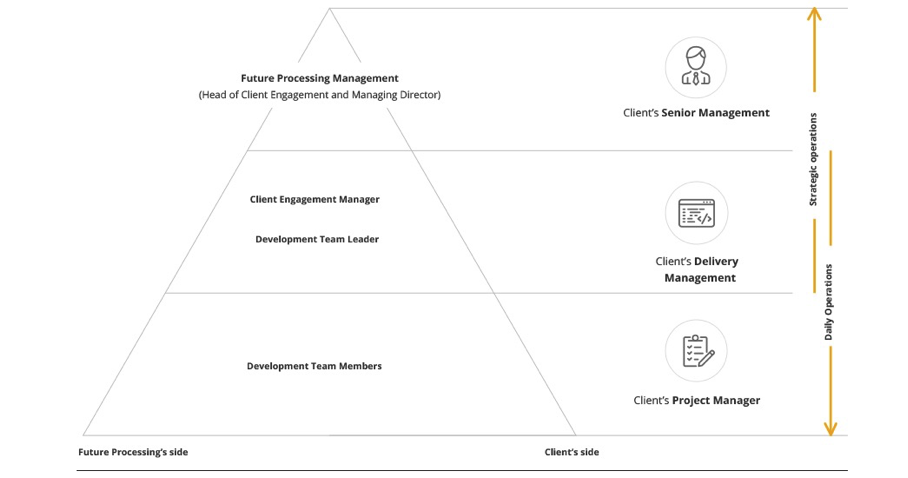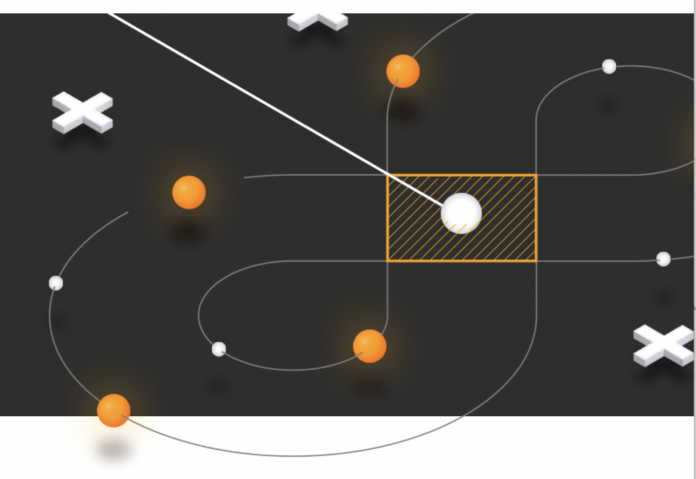future processing, a project development company with more than 1.000 technology professionals, specialized mainly in banking, health and processes, in markets as competitive as Germany and the United Kingdom, among others, shares the keys to its success after more than 20 years in the market .
To understand the importance of the governance structure, we must refer to the context of project management, especially with regard to rules, procedures, roles and distribution of responsibilities within the decision-making process. The governance structure allows the project to be kept under control and that it develops smoothly and according to the established plan.
- What is the most important thing in the governance structure?
- What are the main roles within the governance structure?
- The governance structure in practiceto: The Future Processing Way
- Benefits of having a governance structure
It could even be said that having a governance structure is vital for the success of a project, since it provides precise indications of how to act in different circumstances and removes the chaos factor from the equation.
What is the most important thing in the governance structure?
In order for the governance structure of a project to be valid from start to finish, regardless of the phase it is in, it must be based on a few basic principles:
- Logic: the established framework must be reasonable and logical for all those involved.
- Suitability: there is no single governance structure that is valid for all; it must always be adapted to the entity or project in question.
- Transparency: all information about the governance structure must be clearly expressed, understandable and available to all members of a team.
- repeatability: the mechanisms and procedures involved must be universal, so that they can be used repeatedly in any situation.
- Efficiency: the governance structure should allow a project to run as smoothly and productively as possible; It has to be focused on problem solving.
What are the main roles within the governance structure?
Within the governance structure, the active roles will depend on the methodology chosen for project management. Normally we will find one of the following roles:
- Project Manager: It must be independent from the rest of the interested parties and lead the project on the right track, so that the results desired by the client in terms of needs, values and expectations are achieved.
- Project manager: is in charge of directing the project at the operational level; the project manager clarifies priorities and coordinates work.
- Technical director: focuses exclusively on the technical part of the project.
- team leaders: organize tasks within smaller teams of designers or developers.
- Concerned parties: they have decision-making capacity at the highest level, being able to define needs, set out expectations or report on variations in business objectives.
- Steering committee: This is usually a group consisting of, among others, the project manager and stakeholders, who monitors and approves the overall progress of the project and its results.
The governance structure in practice: The future processing Way
The Customer Commitment manager: our key to success
First of all, and in order to facilitate a strategic plan for the project and project resources, we assign one of our most experienced Customer Engagement Managers to the client account. His main task is to make sure that the client is satisfied with the service provided, and then work together with him to plan a time frame for future projects.
Government program
The objective of our governance program is to establish and maintain a clear organizational structure and also transparent processes and practices to manage the client-company relationship. We deliver it in writing to everyone involved in the project, so that it is clear who is responsible for what and how any new problem should be addressed, step by step. There is no room for guesswork as the project needs to proceed effectively and timely delivery is one of our priorities.
Attached to the program is information on governance principles, roles, responsibilities, committee structures, and protocols. In this way, cooperation is facilitated, the interests of both parties are aligned, the implementation of any modification or amendment is simplified and the process of partial or total termination of a service is structured.
governance operating model
Our governance operating model is based on the following fundamental rules that must be respected by both parties:
- Be proactive and show a receptive and flexible attitude, since this translates into efficient and continuous development.
- Focus on customer satisfaction and customer experience, so that all your needs are met.
- Practice active management that calls to action and keeps the project going.
- Prioritize innovation and continuous improvement to provide avant-garde results, always of the highest quality.
- Maintain harmony in procedures, especially between both parties.
- Collaborate showing a beneficial attitude for all, so that the success of the project translates into achieving or maintaining a competitive advantage for the client and for ourselves.
- Maintain frequent and clear communication so that everything is transparent and there are no obstacles that slow down the development of the project.
- Review and approve important decisions through the management control process, to make sure the project is moving in the right direction.
government meetings
Meetings are of vital importance in our governance model. They are carried out at different levels and affect different aspects of the project:
- strategic review
Every six months, a strategic review takes place or, what is the same, a face-to-face meeting between our board of directors and that of our client. They are held for the purpose of presenting and adjusting the strategic vision and agenda for the coming months, discussing new opportunities and needs, and reviewing financial performance. - Monthly operational meeting
This meeting takes place once a month and we discuss resource updates, project performance against key performance indicators (KPIs), or any risks or issues reported by any of the teams. - Weekly operational meeting
It is the most frequent meeting, in it we review the progress reports and the main delivery risks, and we also talk about any issue regarding the delivery of the current project.
Naturally, before these meetings, we present a list of participants and a detailed program, so that everyone has time to prepare and know what to expect from the meeting.

Benefits of having a governance structure
Having a strong governance structure benefits the entire collaboration, especially in terms of work efficiency and transparency. Main benefits:
- Fewer obstacles or difficulties in the decision-making process, since the procedures and division of responsibilities are clearly defined.
- Increased reliability and trust of our clients, since the risk of possible misunderstandings or communication problems is minimized.
- A better view of progress of our projects, thanks to the open and transparent attitude adopted by the administration at the different levels.
If a project lacks a governance structure, it is very easy to get stuck and lose track. Therefore, we pay special attention to this matter and make sure before any collaboration that the governance model of each project has a solid structure, so that our team and our clients are prepared, fully informed and ready for action.





